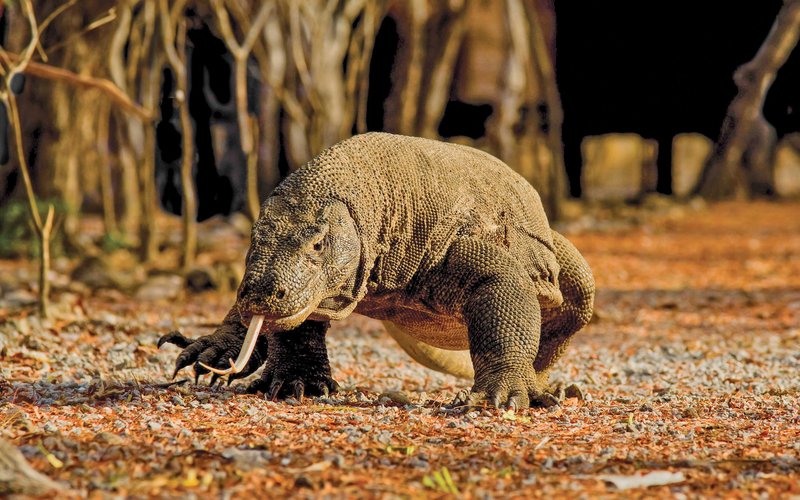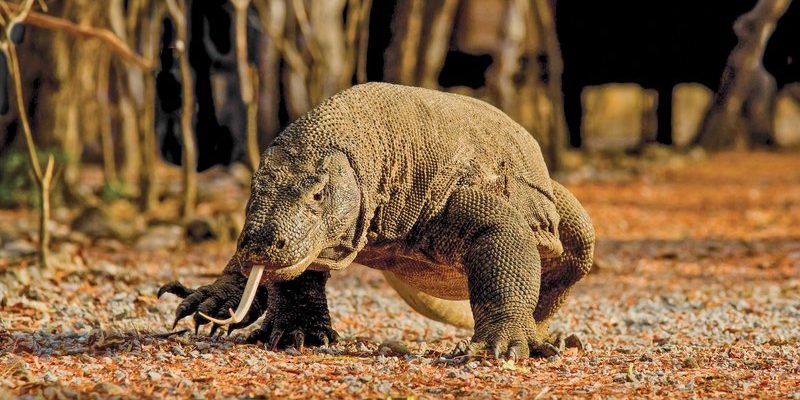
Identifying a Komodo dragon in the wild isn’t as simple as pointing at a picture in a book. They blend in remarkably well with their environment and are more than just impressive in size. Let’s dive into how these incredible creatures behave, what they look like, and a few tips to help you recognize them when wandering their native habitat.
Recognizing the Physical Features of a Komodo Dragon
One of the first things you’ll notice about a Komodo dragon is its size. These reptiles are the largest lizards in the world, reaching lengths of over 10 feet and weighing as much as 200 pounds. If you see a lizard that resembles a small dinosaur, it’s likely a Komodo dragon! Their sturdy bodies and broad heads are distinctive, with strong limbs built for both walking and sprinting.
Their skin is another critical aspect to consider. It’s covered in rough, scaly armor that’s a mix of gray, brown, and green hues. This coloration helps them camouflage among the rocks and vegetation of their habitat. You might be wondering how to distinguish it from other large reptiles in the area—just remember that the Komodo dragon’s tail is long and thick, often as long as its body. It’s powerful enough to help them balance as they move.
If you’re looking closely, you might see their forked tongues flicking in and out. This behavior helps them pick up scents in the air. Imagine a snake’s tongue, but on a creature that massive! Their keen sense of smell is part of why they’re such effective hunters.
Understanding Their Habitat and Behavior
Komodo dragons are native to several islands in Indonesia, including Komodo, Rinca, Flores, and Gili Montang. These fascinating environments range from dry savannas to lush tropical forests, providing the perfect backdrop for these lizards. They prefer areas with plenty of sunlight, so you might find them basking on rocks or lounging in grassy locations.
Their behavior is something else to keep an eye on. Komodo dragons are primarily carnivorous and are often in search of their next meal. They typically hunt deer, wild boars, and even smaller dragons! If you spot a large animal lying down and seemingly uninterested in its surroundings, it could be a Komodo dragon, resting after a hefty meal.
Sometimes, they display a rather intriguing behavior known as “ambush hunting.” This means they can wait for long periods, blending into their surroundings until prey comes too close. Watching an animal so patient and still can feel like being part of a nature documentary!
Spotting Their Tracks and Signs
If you’re not lucky enough to see a Komodo dragon directly, you might find signs of their presence in the area. Tracks can tell you a lot about what wildlife is nearby. The footprints of a Komodo dragon are quite distinct—large and clawed, they can easily measure up to 5 inches wide!
Keep an eye out for scat as well. Komodo dragon droppings are typically large and can contain chunks of fur, bones, or feathers from their last meals. If you see this, you’re definitely in the right territory.
Another sign is their scent. Adult Komodo dragons have a rather pungent smell, often described as reminiscent of rotting meat. If you catch a whiff of something unusual while exploring, that could be your cue to keep your eyes peeled for these majestic reptiles.
Timing Your Search: Best Seasons for Spotting Komodo Dragons
Timing can make all the difference when trying to spot a Komodo dragon. The dry season, which lasts from April to December, is generally the best time for observation. During this period, they are more active and easier to find since they congregate more around watering holes and other shelter.
If you’re willing to brave a bit of humidity, the wet season can also offer unique opportunities. While the dragons may not be as numerous, they do have their own charm during this time, especially when the landscape is lush and vibrant.
Plan your outings during early mornings or late afternoons. This is when these giants are often more active, seeking food or basking in the sun. It’s kind of like tuning into a wildlife channel—catching them in action can be thrilling!
Using Binoculars for a Closer Look
Once you find a good spot, having binoculars handy can enhance your experience. Using binoculars lets you observe these incredible creatures from a safe distance without disturbing them.
Look for features like the color of their skin, the texture of their scales, and their behavior as they interact with their surroundings. It’s a great way to appreciate their beauty without getting too close. Just remember to stay quiet, as loud noises can easily scare them away.
You might also consider using a camera with a good zoom lens if you want to capture their majesty on film (or digital!). Just be sure to respect both the wildlife and the environment during your adventures.
Safety Tips When Observing Komodo Dragons
Safety should always be your top priority when exploring habitats like those of the Komodo dragon. First and foremost, keep a safe distance. Even though they might look lethargic, Komodo dragons are quick on their feet and can be aggressive if they feel threatened.
Make sure you are in a group if possible; these reptiles are more likely to attack solo explorers. Also, avoid wearing strong fragrances as they can attract dragons, thinking you’re an easy target. It’s always best to keep your scent and noise levels minimal.
Lastly, always follow local guidelines or park regulations. Many areas that protect Komodo dragons have specific rules to ensure both your safety and the critters’ well-being, so it’s wise to stick to the trails and listen to any advice from guides.
Identifying a Komodo dragon in the wild can feel like stepping into a world of adventure. With their impressive size, unique behaviors, and intriguing habitats, they offer a once-in-a-lifetime experience for any wildlife enthusiast.
By knowing what to look for—like their physical features, signs of their presence, and safe viewing practices—you increase your chances of spotting these magnificent lizards. So, if you’re planning a trip to Indonesia, keep your eyes wide open and enjoy every moment of this fascinating journey into the realm of Komodo dragons. Happy exploring!

